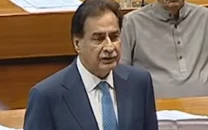Evening programs fail to maintain decorum

While earning a particular degree is the end goal of enrolling into an academic program, attending regular classes is an indispensable part of the journey yet the basic expectation fails to apply in the case of students enrolled in evening programs at public universities in Karachi, which in the absence of an academic decorum have been reduced to mere socialization hubs.
Despite the Sindh government spending millions of rupees for the upkeep of evening programs at public universities in the province, the failure of the College Education Department to supervise the swift conduct of classes and oversee the maintenance of the campus facilities has led to a degradation of the quality of education at the institutions, which fail to attract both students and teachers.
“Only about 100 students took admission in the intermediate classes last year after the college location was shifted. Even when these few students decide to come to college, there is no furniture in the classrooms for them to sit and study. Hence the enrolled students rarely attend classes,” revealed a teacher at the Government Islamia Arts and Commerce College.
Similarly, another professor from the Bawani Government College disclosed that the college had been haphazardly shifted to a government school in a remote area, with only four rooms. “Some teachers have not been performing their duties for a long time but no one asks them anything. The few teachers who do come to college, do not find any students to teach. The college’s budget is around Rs1.5 million per year, but there is no principal to oversee how the funds are spent,” shared the professor.
Shedding light on the other side of the picture, a principal at a college revealed on the condition of anonymity that even when teachers show up for lectures, there are very few students in class. Hence the teachers are forced to spend their time discussing political, social, and international issues before finally going home. Other teachers simply mark their attendance on the biometric machine and leave. We cannot take strict action against them since there really are no students on campus to teach,” regretted the principal.
Concurring with the principal, Professor Zakaullah, Former Principal of the Jamia Millia Government College, shared that he too had to create a special WhatsApp group upon joining the institution in order to encourage students to attend classes regularly.
Zakaullah’s ordeal was supported by data obtained by the Express Tribune from 17 government colleges which indicated that only 500, or 9 per cent of 5,500 enrolled students actually showed up for their classes on any given day despite the College Education Department expending at least Rs764.3 million annually on the salaries of 439 employees in these colleges which cater to students from commerce, humanities, and computer science backgrounds.
These colleges include Government Islamia Arts and Commerce College, Government Jamia Millia Degree College, Government Superior College, Allama Iqbal Government College, Government Degree Arts and Commerce College Landhi, Liaquat Degree Government Boys College, Haji Abdullah Haroon Government Degree College, Government College of Commerce and Economics, SM Arts and Commerce College, Government City College, Siraj-ul-Daula Government College, Quaid-e-Millat Government Degree College, Government Degree Boys College Gulistan-e-Johar, and Government Degree Arts and Commerce College Malir.
“The main issue behind low attendance in colleges is parents’ indifference towards the activities and whereabouts of their children. Children leave their homes on motorcycles to go to college but do not reach their destination and parents do not keep an eye on them. Another reason behind low attendance is the location of these colleges, which makes them out of reach for many students. We have arranged counsellors in colleges to encourage students to attend classes,” asserted Director General of Colleges Sindh, Zahid Rajpar.



















COMMENTS
Comments are moderated and generally will be posted if they are on-topic and not abusive.
For more information, please see our Comments FAQ